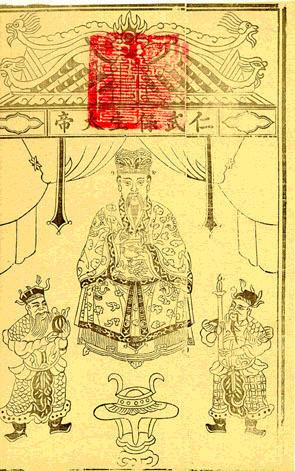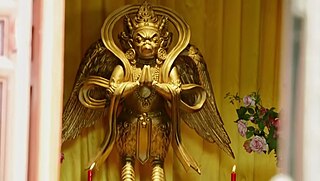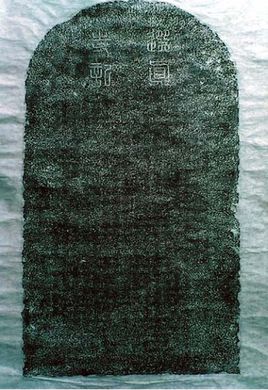
Taoism or Daoism is a diverse philosophical and religious tradition indigenous to China, emphasizing harmony with the Tao—generally understood as an impersonal, enigmatic process of transformation ultimately underlying reality. The concept originates in the Chinese word 道. Although Taoism has no simple definitions, possible translations of Tao include 'way', 'road', and 'technique'. Taoist thought has informed the development of various practices within the Taoist tradition and beyond, including forms of meditation, astrology, qigong, feng shui, and internal alchemy. A common goal of Taoist practice is self-cultivation, a deeper appreciation of the Tao, and more harmonious existence. Taoist ethics vary, but generally emphasize such virtues as effortless action, naturalness, simplicity, and the three treasures of compassion, frugality, and humility.

The Chinese dragon, also loong, is a legendary creature in Chinese mythology, Chinese folklore, and Chinese culture at large. Chinese dragons have many animal-like forms such as turtles and fish, but are most commonly depicted as snake-like with four legs. Academicians have identified four reliable theories on the origin of the Chinese dragon: snakes, Chinese alligators, thunder worship and nature worship. They traditionally symbolize potent and auspicious powers, particularly control over water.
Temple names are posthumous titles accorded to monarchs of the Sinosphere for the purpose of ancestor worship. The practice of honoring monarchs with temple names began during the Shang dynasty in China and had since been adopted by other dynastic regimes in the Sinosphere, with the notable exception of Japan. Temple names should not be confused with era names (年號), regnal names (尊號) or posthumous names (謚號).

Chinese mythology is mythology that has been passed down in oral form or recorded in literature throughout the area now known as Greater China. Chinese mythology encompasses a diverse array of myths derived from regional and cultural traditions. Populated with engaging narratives featuring extraordinary individuals and beings endowed with magical powers, these stories often unfold in fantastical mythological realms or historical epochs. Similar to numerous other mythologies, Chinese mythology has historically been regarded, at least partially, as a factual record of the past.

Religion in China is diverse and most Chinese people are either non-religious or practice a combination of Buddhism and Taoism with a Confucian worldview, which is collectively termed as Chinese folk religion.

Wu Ding ; personal name Zi Zhao (子昭), was a king of the Chinese Shang dynasty who ruled the central Yellow River valley c. 1250 BC – c. 1200 BC. He is the earliest figure in Chinese history mentioned in contemporary records. The annals of the Shang dynasty compiled by later historians were once thought to be little more than legends until oracle script inscriptions on bones dating from his reign were unearthed at the ruins of his capital Yin in 1899. Oracle bone inscriptions from his reign have been radiocarbon dated to 1254–1197 BC ±10 years, closely according with regnal dates derived by modern scholars from received texts, epigraphic evidence, and astronomical calculations.

Chinese folk religion comprises a range of traditional religious practices of Han Chinese, including the Chinese diaspora. This includes the veneration of shen ('spirits') and ancestors, and worship devoted to deities and immortals, who can be deities of places or natural phenomena, of human behaviour, or progenitors of family lineages. Stories surrounding these gods form a loose canon of Chinese mythology. By the Song dynasty (960–1279), these practices had been blended with Buddhist, Confucian, and Taoist teachings to form the popular religious system which has lasted in many ways until the present day. The government of China generally tolerates popular religious organizations, but has suppressed or persecuted those that they fear would undermine social stability.

Jiang Ziya, also known by several other names, was a Chinese military general, monarch, strategist, and writer who helped kings Wen and Wu of Zhou overthrow the Shang in ancient China. Following their victory at Muye, he continued to serve as a Zhou minister. He remained loyal to the regent Duke of Zhou during the Rebellion of the Three Guards; following the Duke's punitive raids against the restive Eastern Barbarians or Dongyi, Jiang was enfeoffed with their territory as the marchland of Qi. He established his seat at Yingqiu. He is also celebrated as one of the main heroes in the Fengshen Bang.

Caishen is the mythological figure worshipped in the Chinese folk religion and Taoism. He has been identified with many historical figures, viewed as his embodied forms, among whom Zhao Gongming, Fan Li, and Bi Gan. A large temple of Caishen was built in the 2000s in Zhouzhi, Xi'an, Shaanxi.
Zu Jia (祖甲) or Di Jia (帝甲), personal name Zǐ Zǎi (子載), was a Shang dynasty King of China. He was the third recorded son of Wu Ding, the first Chinese monarch verified by contemporary records. Having inherited a large area of lands conquered by his father and brother, he led the Shang kingdom through the last brief period of stability. After his reign, Shang went into irreversible decline.

Chinese folklore features a rich variety of ghosts, monsters, and other supernatural creatures. According to traditional beliefs a ghost is the spirit form of a person who has died. Ghosts are typically malevolent and will cause harm to the living if provoked. Many Chinese folk beliefs about ghosts have been adopted into the mythologies and folklore of neighboring East Asian cultures, notably Japan, Korea, and Vietnam. Beliefs about ghosts are closely associated with Chinese ancestor worship, where much have been incorporated into Buddhism and in turn influenced and created uniquely Chinese Buddhist beliefs about the supernatural.

Mount Taibai is a mountain located on the border between Mei, Taibai and Zhouzhi counties in the south west of Shaanxi Province, China. The mount's highest point, Baxian Tower, rises to a height of 3,767 m (12,359 ft) and is the tallest in the Qinling Range, as well as the watershed between the Han River and Wei River. Mount Taibai is also the highest mountain in Eastern China.
Chinese shamanism, alternatively called Wuism, refers to the shamanic religious tradition of China. Its features are especially connected to the ancient Neolithic cultures such as the Hongshan culture. Chinese shamanic traditions are intrinsic to Chinese folk religion.

Poh Seng Tai Tay is a Deity of Medicine worshiped in Chinese folk religion and Taoism. The deity is very popular in Fujian, Taiwan and the Chinese communities in Southeast Asia.
Shang Qu, courtesy name Zimu, was a disciple of Confucius. He studied the I Ching from Confucius, and is credited with the preservation and transmission of the classic.
Dapeng or Great Peng, also known simply as Peng, was a Chinese Bronze Age state that was centered at Xuzhou and Qiuwan in northern Jiangsu. First mentioned on oracle bones dating to the early 11th century BC, Dapeng was a contemporary of the late Shang dynasty, with whom it shared an ambiguous relationship. At times, the two polities were allies and trading partners, but at least on two occasions war broke out among them, eventually leading to Dapeng's destruction by King Di Xin of Shang around 1060 BC.
Chinese theology, which comes in different interpretations according to the Chinese classics and Chinese folk religion, and specifically Confucian, Taoist, and other philosophical formulations, is fundamentally monistic, that is to say it sees the world and the gods of its phenomena as an organic whole, or cosmos, which continuously emerges from a simple principle. This is expressed by the concept that "all things have one and the same principle". This principle is commonly referred to as Tiān 天, a concept generally translated as "Heaven", referring to the northern culmen and starry vault of the skies and its natural laws which regulate earthly phenomena and generate beings as their progenitors. Ancestors are therefore regarded as the equivalent of Heaven within human society, and therefore as the means connecting back to Heaven which is the "utmost ancestral father". Chinese theology may be also called Tiānxué 天學, a term already in use in the 17th and 18th centuries.

The roles of women in Taoism have differed from the traditional patriarchy over women in ancient and imperial China. Chinese women had special importance in some Taoist schools that recognized their transcendental abilities to communicate with deities, who frequently granted women with revealed texts and scriptures. Women first came to prominence in the Highest Clarity School, which was founded in the 4th century by a woman, Wei Huacun. The Tang dynasty (618–907) was a highpoint for the importance of Daoist women, when one-third of the Shangqing clergy were women, including many aristocratic Taoist nuns. The number of Taoist women decreased until the 12th century when the Complete Perfection School, which ordained Sun Bu'er as the only woman among its original disciples, put women in positions of power. In the 18th and 19th centuries, women Taoists practiced and discussed nüdan, involving gender-specific practices of breath meditation and visualization. Furthermore, Taoist divinities and cults have long traditions in China, for example, the Queen Mother of the West, the patron of xian immortality, He Xiangu, one of the Eight Immortals, and Mazu, the protectress of sailors and fishermen.

Dapeng Jinchi Mingwang, also known as the Golden-Winged Great Peng, is a guardian deity in Mahayana Buddhism. He is the spiritual uncle of the Buddha, who gave him a high position in heaven to guard the Pure land. His origins are said to derive from an Indian bird god Garuda. Peng is one of the eight demi-gods of Buddhism. He helps to guard Mount Sumeru and Trāyastriṃśa from attack by the Asuras.

The Cangnan Stele is the temple stele of the Yuan Dynasty Manichaean monastery Xuanzhen Temple (选真寺). It is the only Manichean stone monument found in the world so far. The stele has been listed in China as a national second-class cultural relic, now in the Cangnan County Museum, in Zhejiang Province. The monument is 150 cm high, 76 cm wide, and 10 cm thick, half on the forehead of the round stele; the inscription is inscribed in seal script, "Xuansiji". Lin Wushu called the Xuanzhen Temple according to the inscription "It was built by the church of the neighboring countries of Jiangsu, and was built before the Gai Peng family." It means that the Mingjiao of Xuanzhen Temple still inherits the tradition of Manichaeism in the Tang Dynasty, influenced by foreign religions, and is different from ordinary folk religions.














